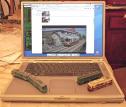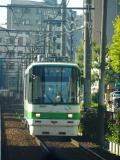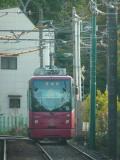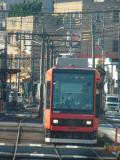
| Home | Open Account | Help | 229 users online |
|
Member Login
Discussion
Media SharingHostingLibrarySite Info |
International Railroad Discussion > Tokyo's "Streetcars"Date: 11/07/22 00:48 Tokyo's "Streetcars" Author: cchan006 TO member Hiroshi has documented one of the surviving streetcar line in Tokyo, the Tokyo Sakura Tram, or Toden Arakawa Line several times here on TO. His latest reports are in the links below:
https://www.trainorders.com/discussion/read.php?6,5470129 https://www.trainorders.com/discussion/read.php?6,5338385 I went joyriding on the Arakawa Line back in 2015, about 2 years before the marketing makeover when City of Tokyo added the nickname, Tokyo Sakura Tram to the operation. Segments of the Arakawa Line has been in operation since 1913, and Arakawa Line is the survivor of the streetcar purge in the 1960s. The English wikipedia entry mentions resident opposition as the reason why this line survives, but the Japanese wikipedia entry adds another, important reason, which is that only 14% of the line mingle with automotive traffic. Many of the Tokyo streetcar lines that were abolished got replaced by subway lines. A close look at the maps strongly hint at that, as many of the subway lines run under major thoroughfares in Tokyo. So the expensive digging did not compromise public transportation needs that much, if at all, but gave the growing automotive traffic (and buses) more room to operate. A great decision in hindsight, as Eidan Subway (Teito Rapid Transit Authority) went public in 2004, and became the publicly-traded Tokyo Metro (profitable). Subway story is not that far off topic, as Tokyo Metro's "competition," city government-subsidized Toei Subway system is operated by Tokyo Metropolitan Bureau of Transportation, the same organization that operate the Tokyo Sakura Tram ("Toei" Arakawa Line). They also operate the extensive bus networks in Tokyo. FYI, even the Toei Subway system has turned operating profit starting in 2006. I decided on a whim to joyride the Arakawa Line 7 years ago. It was a busy railfan day, as I tried to catch JR Freight #3086 (triple-blocked), chased the prototype E235 on the Yamanote Line (only set operating at the time). It took me 7 years, but I'm finally posting this report, as I promised here: https://www.trainorders.com/discussion/read.php?6,3898039,3898115#3898115 - I was hoping to hop on this 7000 Series tram at Waseda, the western terminus. Didn't make it. - I was able to hop on #9001 at Waseda instead, so got lucky. - Video of the joyride on #9001, described next post.   You must be a registered subscriber to watch videos. Join Today! Date: 11/07/22 01:25 Re: Tokyo's "Streetcars" Author: cchan006 #9001 is one of two 9000 Series tram running on the Arakawa Line, and my favorite due its retro design. While I didn't try to catch it, it caught me by luck. It's arriving at Waseda in the second clip in the video.
I'm onboard in the third clip, where #9001 is navigating uphill on its own ROW, away from the street, one of the reasons why the line survived the streetcar purge. It meets another 7000 Series tram. The orange 7000 Series it meets next is in the retro orange paint, the color during the 1970s. I point my video camera toward the Arakawa Barn (Facility) in the fifth clip. In the sixth clip, there's a meet with the sister #9002 at Kumano-Mae Station. This is the transfer point to Nippori-Toneri Liner, categorized as AGT (Automated Guideway Transit) which is driverless. Vancouver, Canada's SkyTrain is also AGT. Tokyo, like other cities around the world has constructed monorails and People Mover systems like these post-streetcars, as these are usually elevated and do not interfere with automotive traffic. I was scouting-as-I-ride and found an elevated spot 3 stations before the terminus, Minowa-Bashi. So I detrained right away to wait for #9001's return trip. #7016 which was tailing the #9001 came by first, then I caught the #9001 returning west toward Waseda next. - Meet with an 8800 Series tram while onboard #9001. - Meet with an 8500 Series. - 7000 Series meet near Minowa-Bashi. #7022 is in the 1970s era retro paint scheme.    Date: 11/07/22 02:51 Re: Tokyo's "Streetcars" Author: cchan006 After joyriding the #9001, going to Shinjuku to try to catch JR Freight #3086, and chasing the Yamanote Line E235 prototype test run via a shorter subway line to Tokyo, I decided to take it easy and headed to the western suburbs of Tokyo, Shimo-Takaido Station on the Keio Corportation's Keio Line. I already had the Tokyo 1-Day Ticket, a day pass that covers the Toei System (Arakawa Line, the Subway Lines and buses), Tokyo Metro, and JR. Toei Shinjuku Line, which has a through train to the Keio Line gave me a free ride to the Keio system, but I did have to pay 3 stations worth of small fare on the Keio Line which is not covered by the day pass. Still, it was a one seat ride on the subway.
Difference in fare is usually calculated where you detrain, by a machine, or by a station agent. In my case, it was calculated by the station agent because my day pass was a paper ticket. Much easier nowadays for users of smart cards (Suica, Pasmo), where the fare is automatically calculated and deducted as you tap and exit. Shimo-Takaido is the northern terminus of the other surviving streetcar line, the Tokyu Setagaya Line, which was my next foaming target. Tokyu Corporation is another profitable railroad in Tokyo, and their system covers the southern suburbs of Tokyo toward Yokohoma. Setagaya Line was part of the Tamagawa Electric Railway (nicknamed "Tama-Den") which became part of Tokyu Corporation by merger in 1938. Much of the former Tama-Den became victim of the streetcar purge, and only the Setagaya Line survived. In the process, it lost the connection to the rest of the Tokyu system at Shibuya, but that connection was partially restored when the subway/underground Den-En-Toshi Line was constructed in the 1970s from Shibuya to Sangen-Jaya (Setagaya Line's southern terminus) and beyond. As with the Tokyo Sakura Tram, Setagaya Line has very litte if any mingling with street traffic, and in fact has no street running except at intersections, if I recall correctly. That's another hint as to why it didn't get purged. This is also the reason for my use of quotes in the title ("Streetcars"). - Tokyu 300 Series sets meet south of Shimo-Takaido. - For now, all of Setagaya Line's train sets are 300 Series, with colorful paint schemes. - Video I took of the Setagaya Line, walking distance from Shimo-Takaido.   You must be a registered subscriber to watch videos. Join Today! Date: 11/07/22 03:50 Re: Tokyo's "Streetcars" Author: cchan006 There's an interesting similarity between the Tokyo Sakura Tram and the Tokyu Setagaya Line. Both are 1372 mm gauge (4' 6"), which is wider than Japan's common 1067 mm gauge (3' 6"), while a bit narrower than 1435 mm (4' 8.5") standard gauge. Keio Line, along with Toei Shinjuku Subway Line is also 1372 mm gauge.
In the third picture, there's a dark green tram model behind #9001. That's Tokyu Deha 80, which used to run on the Setagaya Line. I remember seeing it decades ago, but unfortunately, I was unable to document it before it stopped running in 2001. - Orange-colored 300 Series approaching Shimo-Takaido. - Inside Shimo-Takaido Station. Not visible, but Keio Line's platforms are to the right. - Combining hobbies: Retro-computing (Macintosh PowerBook G4 "Titanium"), and streetcar models. That's it for the report.    Date: 11/07/22 20:22 Re: Tokyo's "Streetcars" Author: Ritzville Very enjoyable videos!
Larry Date: 11/10/22 03:16 Re: Tokyo's "Streetcars" Author: Hiroshi Date: 11/11/22 16:00 Re: Tokyo's "Streetcars" Author: cchan006 Hiroshi Wrote:
------------------------------------------------------- > Here are a few photos of the Tokyo Sakura Tram at > the Minwa-Bashi stop. Hiroshi-san, Thanks for posting these, with #9001 and #7703 together. More interesting factoid for the TO members: 7700 Series trams are actually "recycled," manufactured in 2016 with reusable parts (trucks, body, other components) from the 7000 Series trams seen in my video. So while the Showa Era (1960s to 1980s) "look" of the Arakawa Line lives on in the form of the 7700 Series, most of the original 7000 Series are gone. #7016, #7019, and #7022 in my video have all been scrapped, and others have gone west to continue running on the Toyohashi Railroad, located about 180 miles from Tokyo or 40 miles from Nagoya. #7022 was the last 7000 Series to run on the Tokyo Sakura Tram in regular service until December 2018. So my video is nostalgia material. That's an interesting parallel to the Tokyu 7700 Series EMUs I reported on 4 years ago, and not just the matching series numbers. They were Japan's first Budd-licensed stainless steel bodied train sets to be manufactured domestically as Series 7000, and were converted from DC to AC traction to prolong its usefulness for another 3+ decades. Like the trams, some of the Tokyu EMUs have gone to other railroads to continue running. And the "recycling" is Japan's rail organizations walking the walk on "Going Green", where modern electrical components allow the trains to run more energy efficiently, while non-motive components are recycled to save resources on manufacturing brand new parts. In fact, Tokyo Sakura Tram saved money by ordering fewer brand new 8900 Series trams (8 instead of 16) by recycling the 7000 Series to 7700 Series. Here are 3 more video clips of my joyride on the retro-look but modern #9001. I met several 8800 Series trams in the video, but these document the higher ridership segments on the Tokyo Sakura Tram, the connections to JR East trains at Otsuka and Oji stations. Otskua is served by the famous Yamanote Loop Line, and Oji is served by Keihin-Tohoku Line. That's another reason why the Arakawa Line survives today, connection to a (significantly) higher ridership system The approach to Oji in the 2nd clip is interesting, as you see two fast food joints (McDonald's and Sukiya) and the tram runs under the Shinkansen viaduct. At the end of the clip, I cut the video short as I'm getting blocked by bunch of riders coming on board. Sukiya is a competitor to Yoshinoya, the original beef bowl chain in Japan and abroad... and I often choose Sukiya over Yoshinoya when I'm visiting Japan. #9001 stretches its legs a little on a relative flat straight tracks in the last clip, where it meets another 8800 Series. You must be a registered subscriber to watch videos. Join Today! Date: 11/12/22 04:49 Re: Tokyo's "Streetcars" Author: Hiroshi Here are some of the photos of Tokyo Sakura Trams:
Class 8500, Class 8800, and Class 8900. In short, omits the 4th dights; drivers call them 501, 801, and 901 respectively. This tells you why class 7700 was renumbered in such a way after the re-fabrication. Hiroshi    Date: 11/13/22 21:53 Re: Tokyo's "Streetcars" Author: railstiesballast A fun post, thank you for sharing.
Date: 11/14/22 20:54 Re: Tokyo's "Streetcars" Author: Hiroshi Date: 11/17/22 02:55 Re: Tokyo's "Streetcars" Author: Hiroshi |